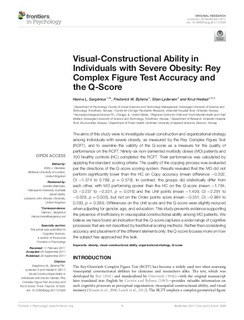| dc.contributor.author | Sargenius, Hanna | |
| dc.contributor.author | Bylsma, Frederick | |
| dc.contributor.author | Lydersen, Stian | |
| dc.contributor.author | Hestad, Knut | |
| dc.date.accessioned | 2018-04-27T13:15:44Z | |
| dc.date.available | 2018-04-27T13:15:44Z | |
| dc.date.created | 2017-09-13T15:43:45Z | |
| dc.date.issued | 2017 | |
| dc.identifier.citation | Frontiers in Psychology. 2017, 8 (1629), . | nb_NO |
| dc.identifier.issn | 1664-1078 | |
| dc.identifier.uri | http://hdl.handle.net/11250/2496423 | |
| dc.description.abstract | The aims of this study were to investigate visual-construction and organizational strategy among individuals with severe obesity, as measured by the Rey Complex Figure Test (RCFT), and to examine the validity of the Q-score as a measure for the quality of performance on the RCFT. Ninety-six non-demented morbidly obese (MO) patients and 100 healthy controls (HC) completed the RCFT. Their performance was calculated by applying the standard scoring criteria. The quality of the copying process was evaluated per the directions of the Q-score scoring system. Results revealed that the MO did not perform significantly lower than the HC on Copy accuracy (mean difference −0.302, CI −1.374 to 0.769, p = 0.579). In contrast, the groups did statistically differ from each other, with MO performing poorer than the HC on the Q-score (mean −1.784, CI −3.237 to −0.331, p = 0.016) and the Unit points (mean −1.409, CI −2.291 to −0.528, p = 0.002), but not on the Order points score (mean −0.351, CI −0.994 to 0.293, p = 0.284). Differences on the Unit score and the Q-score were slightly reduced when adjusting for gender, age, and education. This study presents evidence supporting the presence of inefficiency in visuospatial constructional ability among MO patients. We believe we have found an indication that the Q-score captures a wider range of cognitive processes that are not described by traditional scoring methods. Rather than considering accuracy and placement of the different elements only, the Q-score focuses more on how the subject has approached the task. | nb_NO |
| dc.description.sponsorship | The authors had no conflict of interest when conducting this research. Innlandet Hospital Trust provided the funding for this study. | nb_NO |
| dc.language.iso | eng | nb_NO |
| dc.rights | Navngivelse 4.0 Internasjonal | * |
| dc.rights.uri | http://creativecommons.org/licenses/by/4.0/deed.no | * |
| dc.subject | obesity | nb_NO |
| dc.subject | visual-constructional ability | nb_NO |
| dc.subject | organizational strategy | nb_NO |
| dc.subject | Q-score | nb_NO |
| dc.title | Visual-Constructional Ability in Individuals with Severe Obesity: Rey Complex Figure Test Accuracy and the Q-Score | nb_NO |
| dc.type | Journal article | nb_NO |
| dc.type | Peer reviewed | nb_NO |
| dc.description.version | publishedVersion | nb_NO |
| dc.rights.holder | Copyright © 2017 Sargénius, Bylsma, Lydersen and Hestad. This is an open-access article distributed under the terms of the Creative Commons Attribution License (CC BY). The use, distribution or reproduction in other forums is permitted, provided the original author(s) or licensor are credited and that the original publication in this journal is cited, in accordance with accepted academic practice. No use, distribution or reproduction is permitted which does not comply with these terms. | nb_NO |
| dc.source.pagenumber | 11 | nb_NO |
| dc.source.volume | 8 | nb_NO |
| dc.source.journal | Frontiers in Psychology | nb_NO |
| dc.source.issue | 1629 | nb_NO |
| dc.identifier.doi | 10.3389/fpsyg.2017.01629 | |
| dc.identifier.cristin | 1493441 | |
| cristin.unitcode | 1991,9,1,0 | |
| cristin.unitcode | 1991,1,2,0 | |
| cristin.unitname | Avd Alderspsykiatri | |
| cristin.unitname | Avd Forskning | |
| cristin.ispublished | true | |
| cristin.fulltext | original | |
| cristin.qualitycode | 2 | |

